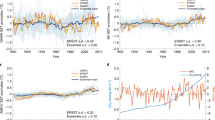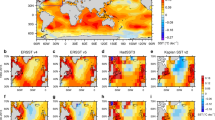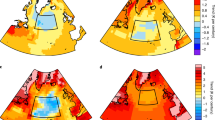Abstract
The asynchronous relationship between millennial-scale temperature changes over Greenland and Antarctica during the last glacial period has led to the notion of a bipolar seesaw which acts to redistribute heat depending on the state of meridional overturning circulation within the Atlantic Ocean. Here we present new records from the South Atlantic that show rapid changes during the last deglaciation that were instantaneous (within dating uncertainty) and of opposite sign to those observed in the North Atlantic. Our results demonstrate a direct link between the abrupt changes associated with variations in the Atlantic meridional overturning circulation and the more gradual adjustments characteristic of the Southern Ocean. These results emphasize the importance of the Southern Ocean for the development and transmission of millennial-scale climate variability and highlight its role in deglacial climate change and the associated rise in atmospheric carbon dioxide.
This is a preview of subscription content, access via your institution
Access options
Subscribe to this journal
Receive 51 print issues and online access
$199.00 per year
only $3.90 per issue
Buy this article
- Purchase on Springer Link
- Instant access to full article PDF
Prices may be subject to local taxes which are calculated during checkout



Similar content being viewed by others
References
Stuiver, M. & Grootes, P. M. GISP2 oxygen isotope ratios. Quat. Res. 53, 277–283 (2000)
Bard, E., Rostek, F., Turon, J. L. & Gendreau, S. Hydrological impact of Heinrich events in the subtropical northeast Atlantic. Science 289, 1321–1324 (2000)
Shackleton, N. J., Hall, M. A. & Vincent, E. Phase relationships between millennial-scale events 64,000-24,000 years ago. Paleoceanography 15, 565–569 (2000)
Blunier, T. & Brook, E. J. Timing of millennial-scale climate change in Antarctica and Greenland during the last glacial period. Science 291, 109–112 (2001)
EPICA Community Members. One-to-one coupling of glacial climate variability in Greenland and Antarctica. Nature 444, 195–198 (2006)
Crowley, T. J. North Atlantic deep water cools the Southern Hemisphere. Paleoceanography 7, 489–497 (1992)
Broecker, W. S. Paleocean circulation during the last deglaciation: A bipolar seesaw? Paleoceanography 13, 119–121 (1998)
Vellinga, M. & Wood, R. A. Global climatic impacts of a collapse of the Atlantic thermohaline circulation. Clim. Change 54, 251–267 (2002)
Schmittner, A., Saenko, O. A. & Weaver, A. J. Coupling of the hemispheres in observations and simulations of glacial climate change. Quat. Sci. Rev. 22, 659–671 (2003)
Rind, D. et al. Effects of glacial meltwater in the GISS coupled atmosphere-ocean model - 2. A bipolar seesaw in Atlantic Deep Water production. J. Geophys. Res. 106, 27355–27365 (2001)
Stocker, T. F. & Johnsen, S. J. A minimum thermodynamic model for the bipolar seesaw. Paleoceanography 18 10.1029/2003PA000920 (2003)
Wang, X. F. et al. Wet periods in northeastern Brazil over the past 210 kyr linked to distant climate anomalies. Nature 432, 740–743 (2004)
Lamy, F. et al. Modulation of the bipolar seesaw in the southeast pacific during Termination 1. Earth Planet. Sci. Lett. 259, 400–413 (2007)
McManus, J. F., Francois, R., Gherardi, J. M., Keigwin, L. D. & Brown-Leger, S. Collapse and rapid resumption of Atlantic meridional circulation linked to deglacial climate changes. Nature 428, 834–837 (2004)
Denton, G. H., Broecker, W. S. & Alley, R. B. The mystery interval 17.5 to 14.5 kyrs ago. PAGES News 14, 14–16 (2006)
Barker, S. & Knorr, G. Antarctic climate signature in the Greenland ice core record. Proc. Natl Acad. Sci. USA 104, 17278–17282 (2007)
Ninnemann, U. S. & Charles, C. D. Regional differences in quaternary Subantarctic nutrient cycling: Link to intermediate and deep water ventilation. Paleoceanography 12, 560–567 (1997)
Kanfoush, S. L. et al. Millennial-scale instability of the Antarctic ice sheet during the last glaciation. Science 288, 1815–1818 (2000)
Johnsen, S. J., Dansgaard, W., Clausen, H. B. & Langway, C. C. Oxygen isotope profiles through Antarctic and Greenland ice sheets. Nature 235, 429–434 (1972)
Niebler, H. S. & Gersonde, R. A planktic foraminiferal transfer function for the southern South Atlantic Ocean. Mar. Micropaleontol. 34, 213–234 (1998)
Peeters, F. J. C. et al. Vigorous exchange between the Indian and Atlantic oceans at the end of the past five glacial periods. Nature 430, 661–665 (2004)
Arz, H. W., Patzold, J. & Wefer, G. The deglacial history of the western tropical Atlantic as inferred from high resolution stable isotope records off northeastern Brazil. Earth Planet. Sci. Lett. 167, 105–117 (1999)
Kim, J. H., Schneider, R. R., Muller, P. J. & Wefer, G. Interhemispheric comparison of deglacial sea-surface temperature patterns in Atlantic eastern boundary currents. Earth Planet. Sci. Lett. 194, 383–393 (2002)
Farmer, E. C., deMenocal, P. B. & Marchitto, T. M. Holocene and deglacial ocean temperature variability in the Benguela upwelling region: Implications for low-latitude atmospheric circulation. Paleoceanography 20 10.1029/2004PA001049 (2005)
Barker, S., Cacho, I., Benway, H. & Tachikawa, K. Planktonic foraminiferal Mg/Ca as a proxy for past oceanic temperatures: a methodological overview and data compilation for the Last Glacial Maximum. Quat. Sci. Rev. 24, 821–834 (2005)
Mashiotta, T. A., Lea, D. W. & Spero, H. J. Glacial-interglacial changes in Subantarctic sea surface temperature and δ18O-water using foraminiferal Mg. Earth Planet. Sci. Lett. 170, 417–432 (1999)
Berger, W. H. Planktonic foraminifera: selective solution and the lysocline. Mar. Geol. 8, 111–138 (1970)
Gooday, A. J. A response by benthic Foraminifera to the deposition of phytodetritus in the deep sea. Nature 332, 70–73 (1988)
Cornelius, N. & Gooday, A. J. 'Live' (stained) deep-sea benthic foraminiferans in the western Weddell Sea: trends in abundance, diversity and taxonomic composition along a depth transect. Deep-Sea Res. II 51, 1571–1602 (2004)
Froneman, P. W., Laubscher, R. K. & McQuaid, C. D. Size-fractionated primary production in the south Atlantic and Atlantic sectors of the Southern Ocean. J. Plankton Res. 23, 611–622 (2001)
Saraceno, M., Provost, C. & Piola, A. R. On the relationship between satellite-retrieved surface temperature fronts and chlorophyll a in the western South Atlantic. J. Geophys. Res. 110 10.1029/2004JC002736 (2005)
Llido, J., Garcon, V., Lutjeharms, J. R. E. & Sudre, J. Event-scale blooms drive enhanced primary productivity at the Subtropical Convergence. Geophys. Res. Lett. 32 10.1029/2005GL022880 (2005)
Machu, E. et al. Phytoplankton distribution in the Agulhas system from a coupled physical-biological model. Deep-Sea Res. I 52, 1300–1318 (2005)
Bathmann, U. V., Scharek, R., Klaas, C., Dubischar, C. D. & Smetacek, V. Spring development of phytoplankton biomass and composition in major water masses of the Atlantic sector of the Southern Ocean. Deep-Sea Res. II 44, 51–67 (1997)
Sachs, J. P. & Anderson, R. F. Increased productivity in the subantarctic ocean during Heinrich events. Nature 434, 1118–1121 (2005)
Timmermann, A., Krebs, U., Justino, F., Goosse, H. & Ivanochko, T. Mechanisms for millennial-scale global synchronization during the last glacial period. Paleoceanography 20 10.1029/2004PA001090 (2005)
Knorr, G. & Lohmann, G. Southern Ocean origin for the resumption of Atlantic thermohaline circulation during deglaciation. Nature 424, 532–536 (2003)
Knorr, G. & Lohmann, G. Rapid transitions in the Atlantic thermohaline circulation triggered by global warming and meltwater during the last deglaciation. Geochem. Geophys. Geosyst. 8 10.1029/2007GC001604 (2007)
Cox, M. D. An idealized model of the world ocean. 1. The global-scale water masses. J. Phys. Oceanogr. 19, 1730–1752 (1989)
Li, C., Battisti, D. S., Schrag, D. P. & Tziperman, E. Abrupt climate shifts in Greenland due to displacements of the sea ice edge. Geophys. Res. Lett. 32 10.1029/2005GL023492 (2005)
Monnin, E. et al. Atmospheric CO2 concentrations over the last glacial termination. Science 291, 112–114 (2001)
Ahn, J. & Brook, E. J. Atmospheric CO2 and climate from 65 to 30 ka B.P. Geophys. Res. Lett. 34 10.1029/2007GL029551 (2007)
Toggweiler, J. R., Russell, J. L. & Carson, S. R. Midlatitude westerlies, atmospheric CO2, and climate change during the ice ages. Paleoceanography 21 10.1029/2005PA001154 (2006)
Kohler, P., Fischer, H., Munhoven, G. & Zeebe, R. E. Quantitative interpretation of atmospheric carbon records over the last glacial termination. Glob. Biogeochem. Cycles 19 10.1029/2004GB002345 (2005)
Spero, H. J. & Lea, D. W. The cause of carbon isotope minimum events on glacial terminations. Science 296, 522–525 (2002)
Hays, J. D., Imbrie, J. & Shackleton, N. J. Variations in the Earth’s orbit: Pacemaker of the ice ages. Science 194, 1121–1132 (1976)
Raymo, M. E. The timing of major climate terminations. Paleoceanography 12, 577–585 (1997)
Barker, S., Greaves, M. & Elderfield, H. A study of cleaning procedures used for foraminiferal Mg/Ca paleothermometry. Geochem. Geophys. Geosyst. 4 10.1029/2003GC000559 (2003)
Charles, C. D., Lynch-Stieglitz, J., Ninnemann, U. S. & Fairbanks, R. G. Climate connections between the hemispheres revealed by deep sea sediment core/ice core correlations. Earth Planet. Sci. Lett. 142, 19–27 (1996)
Locarnini, R. A., Mishonov, A. V., Antonov, J. I., Boyer, T. P. & Garcia, H. E. World Ocean Atlas 2005, Volume 1: Temperature (ed. Levitus, S.) (NOAA Atlas NESDIS 61, US Govt Printing Office, 2006)
Stuiver, M. & Reimer, P. J. Extended 14C data-base and revised Calib 3.0 14C age calibration program. Radiocarbon 35, 215–230 (1993)
Hughen, K. A. et al. Marine04 marine radiocarbon age calibration, 0-26 cal kyr BP. Radiocarbon 46, 1059–1086 (2004)
Fairbanks, R. G. et al. Radiocarbon calibration curve spanning 0 to 50,000 years BP based on paired Th-230/U-234/U-238 and C-14 dates on pristine corals. Quat. Sci. Rev. 24, 1781–1796 (2005)
Bard, E. Correction of accelerator mass spectrometry 14C ages measured in planktonic foraminifera: paleoceanographic implications. Paleoceanography 3, 635–645 (1988)
Kennett, J. P. & Srinivasan, M. S. Neogene Planktonic Foraminifera: A Phylogenetic Atlas (Wiley, 1983)
Andersen, K. K. et al. A 60 000 year Greenland stratigraphic ice core chronology. Clim. Past Discuss. 3, 1235–1260 (2007)
Parrenin, F. et al. The EDC3 chronology for the EPICA dome C ice core. Clim. Past 3, 485–497 (2007)
Acknowledgements
We thank J. Riker and C. Lear for analytical advice and assistance and H. Medley for help with sediment processing. Sample material used in this project was provided by the Lamont-Doherty Earth Observatory Deep-Sea Sample Repository. We thank R. Lotti and G. Lozefski for help with sampling. Support for the collection and curating facilities of the core collection is provided by the US National Science Foundation through grant OCE00-02380 and the Office of Naval Research through grant N00014-02-1-0073. The work was supported by a National Science Foundation grant (OCE-0435703) to W.S.B. and S.B.
Author Contributions S.B. designed the research and performed foraminiferal Mg/Ca analyses, P.D. performed benthic foraminiferal counts and picked planktonic foraminifera for 14C dating and Mg/Ca analyses, M.J.V. performed planktonic foraminiferal counts, J.P. performed diatom counts and G.K. helped with interpretation. All authors contributed towards preparing the manuscript.
Author information
Authors and Affiliations
Corresponding author
Supplementary information
Supplementary Information
This file contains Supplementary Data, Supplementary References, Supplementary Table S1 and Supplementary Figures S1-S9 with Legends (PDF 798 kb)
Rights and permissions
About this article
Cite this article
Barker, S., Diz, P., Vautravers, M. et al. Interhemispheric Atlantic seesaw response during the last deglaciation. Nature 457, 1097–1102 (2009). https://doi.org/10.1038/nature07770
Received:
Accepted:
Issue Date:
DOI: https://doi.org/10.1038/nature07770
This article is cited by
-
Sea ice-ocean coupling during Heinrich Stadials in the Atlantic–Arctic gateway
Scientific Reports (2024)
-
Southern Ocean glacial conditions and their influence on deglacial events
Nature Reviews Earth & Environment (2023)
-
Arctic and Antarctic forcing of ocean interior warming during the last deglaciation
Scientific Reports (2023)
-
Bipolar impact and phasing of Heinrich-type climate variability
Nature (2023)
-
Organic Carbon Deposition on the Inner Shelf of the East China Sea Constrained by Sea Level and Climatic Changes Since the Last Deglaciation
Journal of Ocean University of China (2023)
Comments
By submitting a comment you agree to abide by our Terms and Community Guidelines. If you find something abusive or that does not comply with our terms or guidelines please flag it as inappropriate.



